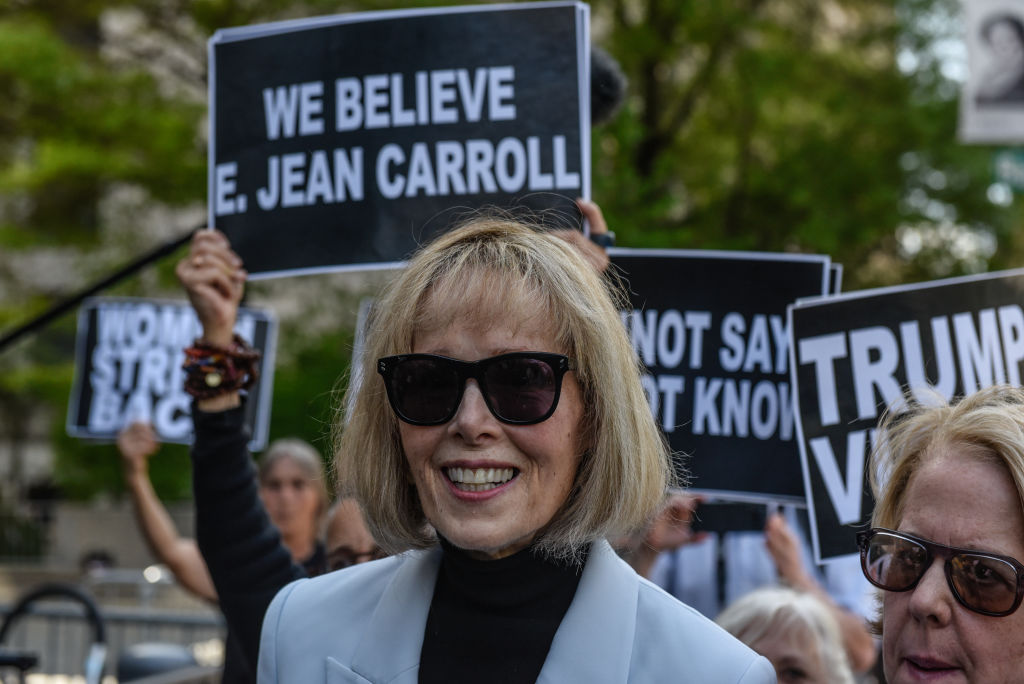
E. Jean Carroll sued Donald Trump in a civil lawsuit relating to an assault in a Bergdorf’s dressing room in the 1990s. There were no witnesses, no photos, no relevant DNA, no significant evidentiary record of any kind. It was her story versus his—and this jury, at least, sided with Carroll. But do most people really believe her? This case may be over, but the question matters for the future. A lot.
Reactions to the verdict are already following a pattern: Women were likely to say, “Absolutely, I believed her. That stuff happens. Especially in those days.” But for men—even open-minded ones—the Carroll story was just too damn unfamiliar.
Carroll said she fought Trump’s sexual advances, yet she didn’t notify the police. She says she habitually told people she was “fine, fantastic,” yet remained traumatized by the assault, and struggled to form romantic relationships as a result. She says she told a friend about the alleged attack shortly afterward, but then the two friends didn’t talk about it for a quarter century.
To put her claims in context: Between 1992 and 2000, barely a third of all rapes were reported to the police. Carroll’s failure to report her attack to the police is (unfortunately) firmly in the mainstream.
The long term psychological consequences of rape are also well–established; they can include fear, anxiety, depression, sexual dysfunction and social adjustment issues—so from a criminal and medical perspective, Carroll’s claims are completely routine.
But it was Carroll’s story that people listened to. They asked themselves, “Does that really make sense? Wouldn’t I have contacted the police if it had been me? Would I have felt traumatized by this one incident for the rest of my life?” And that story explains the difference in reactions between so many men and women.
Most men simply don’t get women’s stories. I’m not saying they don’t understand them, or even that they disagree with them. Men literally are not exposed to women’s stories: They exist by and large in a protective bubble of male narratives, and this has huge consequences.
- Women will read books written by men, but men don’t read books by women: Men account for only 19 percent of the audience for the top 10 best-selling female authors (Jane Austen and Margaret Atwood among them).
- Men don’t see women’s perspectives on screen: Last year, merely 11 percent of the 100 top-grossing films were directed by women.
- In advertisements, men appear four times as often as women and have seven times as many speaking parts.
- Men don’t see photos by women—over 80 percent of photojournalists are men.
- Broadway plays? The percent of those written by women is perhaps 20 percent, in a good year.
- Artworks in the permanent collections of nearly all major museums are overwhelmingly made by men, and that’s not just the collecting practices of the past: In 26 major museums over a recent 10-year period, just 11 percent of acquisitions and 14 percent of exhibitions were of female artists.
I could go on.
Men are used to having their views seen as mainstream and their experiences treated as default human experiences.If men don’t see, hear, read or listen to women’s stories, it is no surprise that they don’t understand women’s psyches or have insights into the reality of a female experience. And thus, notwithstanding the Carroll verdict, I cannot help but feel like women will be treading on thin ice in similar cases in the future, always wondering, “Do they get this? Do men understand and see our reality at all?”
So women? Keep telling your stories.
And men? How about letting those stories in? Watch women’s movies, read their books, see their artwork. You might just learn something about half the population.
Up next:
U.S. democracy is at a dangerous inflection point—from the demise of abortion rights, to a lack of pay equity and parental leave, to skyrocketing maternal mortality, and attacks on trans health. Left unchecked, these crises will lead to wider gaps in political participation and representation. For 50 years, Ms. has been forging feminist journalism—reporting, rebelling and truth-telling from the front-lines, championing the Equal Rights Amendment, and centering the stories of those most impacted. With all that’s at stake for equality, we are redoubling our commitment for the next 50 years. In turn, we need your help, Support Ms. today with a donation—any amount that is meaningful to you. For as little as $5 each month, you’ll receive the print magazine along with our e-newsletters, action alerts, and invitations to Ms. Studios events and podcasts. We are grateful for your loyalty and ferocity.





